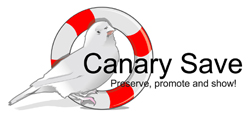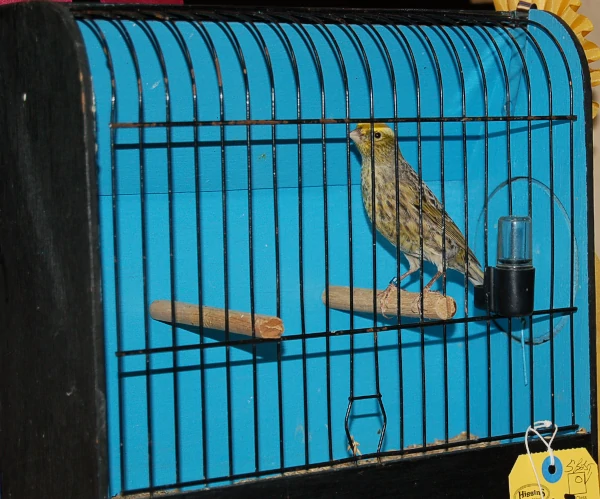
Characteristics
This canary has a medium, slender, slim and smooth body without being overly stylized. A lively canary that is easy to breed.
The Portuguese Harlequin must be red ground and color fed. The mosaic pattern must be present making the required slender build hard to produce. You must see the mosaic pattern (red factor) and melanic patterns along its body.
The position should be upright and tall forming a sixty degree (60) angle in relation to the perch. Head should be upright. The liveness, and position when jumping from perch to perch is also important during evaluation. Length should be 16cm (about 6.5 inches), well proportioned in all areas of the body. Feather should be of very good quality, smooth, compact, silky, brilliant and very close to the body and perfectly define the shape of the bird.
The bird must have a balanced multicolor, showing red factor, mosaic and a uniform melanin-lipochrome distribution. Birds that show symmetric patterns within the above guidelines should be considered superior specimens to those that lack symmetry.
Exhibition examples should be a combination of six colors: red/orange, white, gray, chestnut, black and bronze. The bird should obviously be variegated with lots of melanins, uniformly distributed thought the body including the wings and tail. We cannot forget that the random distribution of color/variegation will not allow us to obtain a rigidly defined pattern. However we prefer a uniform, proportioned distribution of color and pattern. Birds that show a symmetric variegated pattern are consideration the best examples of this breed. When showing in teams all birds should be as close as possible in pattern and color distribution.
Show specimens should be proportionally variegated with only 50% melanin (a mixture of black and or brown) covering the body.
The 50% lipochrome should show some red ground parts and areas of white (chalk white) feathers.
Dilute colors (agate, ivory, etc…) are allowed. Color feeding is mandatory.
The breed comes in the crested and non-crested forms.
On crested birds the crest should be tight and in the shape of a tricorn hat having two angles in the back and one in front. The crest must be symmetric and should fall neatly over the sides without covering the eyes or the beak. The eyes and beak MUST be visible. The crest is produced by the same gene that gives us birds with oval or round shaped crests. Therefore the required vertex (tip) at the front of the crest can only be partially achievable and will rarely be in the the shape of an angle. Because of the crested gene the tip at the front of the crest will be somewhat rounded and should be considered a virtual angle. The two angles at the back of the crest are usually better defined and should show much better angulation. Light rise of the feathers on the nape are acceptable, however it is preferable that the feathers fall neatly at the back of the head. Crest feathers should symmetrically come from a central well defined location but not as small as as defined by Gloster standards. Crest feathers should be short.
On non-crested birds the head should be smooth, narrower and longer with the back of the head being wider. When seeing from above the head should be “U” shaped narrowing towards the base of the beak. Eyes should be centered, clear and clearly visible with a strong beak proportional to the rest of the head. Neck should be well defined clearing showing a separation between the head and the body giving the bird a lively appearance.
The length and position of the neck should be well proportioned with the rest of the body. The zones unifying the head, neck and body should be well defined without any sharp angles.
The chest should be uniformly rounded having a harmonious shape with the rest of the body, high and robust without being excessively wide or large.
The back should be absent of angles, not be rounded or concave and should form a straight line with the tail.
Wings should be closely folded and join at the base of the tail. Wings should be proportionally large and should not cross or open and held tight to the body.
The tail should be long and narrow, however it should not exceed one third of the total length of the bird. A proper tail should complement the body, giving the bird an even proportional look. The tip of the tail should be open because of the length of the feathers. It should be as variegated as possible comprised of melanic and lipochromic feathers.
Legs should be strong, large and lightly flexed showing some thigh. The legs should show some variegation and not be totally melanistic or clear. Broken nails are allowed but penalized. Missing nails and or corkscrew nails may be a disqualifying condition (check club/show policy).
Lively, clean, healthy, show trained birds are expected on the show bench.


